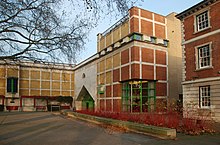Tate Britain
The Tate Britain (a previous name was the Tate Gallery of British Art ) is a museum in London that exhibits the world's largest collection of British art from the 16th to the 21st centuries.
history

At the end of the 19th century, the sugar millionaire Sir Henry Tate made an offer to the British government: if they could provide the property, he would have a gallery for modern British art built there and his own collection of over 60 paintings by renowned British artists of the nation as Bequeath the foundation of the exhibition. Millbank was chosen as the location , the largest London prison there was demolished, and the Tate Gallery opened its doors on July 21, 1897 in a neoclassical building on the banks of the Thames designed by Sidney RJ Smith . The collection was supposed to be limited to British artists born after 1790, but donations such as the Turner estate ( William Turner was born in 1775) and a collection of Impressionists led to a reorientation. From 1917 international artists as well as British born before 1790 were admitted. The Tate Gallery presented itself with two main themes: English painting from the 16th to the late 19th century and international modern painting since 1880. In 1955 the Tate Gallery was also formally separated from the National Gallery and in 1968 it was decided that the collections British painters should be more clearly defined in any gallery.
In the newly built Clore Gallery, designed by Sir James Stirling and made possible by the Clore Foundation, which opened in 1987, the estate of William Turner can now also be appropriately represented.
In order to be able to adequately present what is now the world's largest collection of British art, it was decided a few years ago to split the museum. The holdings of International Contemporary Art have been on view since 2000 in the new Tate Gallery of Modern Art in the building of the former Bankside Power Station. Today at Tate Britain the works are shown in themed galleries. Additional rooms have been created for many exhibits that had been stored for years due to lack of space. In fact, 35% exhibition capacity could be gained. Tate Britain is once again showing its original concept and documenting British art from 1500 to the present day.
collection
There are around 3500 paintings, prints and sculptures. New works are added every year. The naive formalism of the portraits from the Tudor and Stuart periods is exemplified by the anonymous work Die Schwestern Cholmondeley (1600–1610), two sisters who were born on the same day, married and gave birth to their first children, or Hans Eworth's Portrait of a Lady ( 1565-1568). Evert Collier's Trompe l'Oeil of Newspapers (around 1695–1700) is also exceptional .
In the 18th century, British painters responded to the Enlightenment. William Hogarth's paintings include a series of his servants (around 1750–1755). George Stubbs ' horse, devoured by a lion (around 1765) and The Harvesters (1785), as well as Reynold's painting The Three Graces adorn a Hymen-Terme (1774) and various works by Gainsborough, including Giovanna Baccelli (around 1782), also hang here . One of the exhibited international artists is the American John Singer Sargent with the paintings Carnation, Lily, Lily, Rose (1885–1886) and Portrait of Mrs Barnard (1885).
Exhibitions
- 2017: Queer British Art 1861–1967 . Catalog.
literature
- Eugen Külborn (editor): Galeria Mundi. A trip through the museums . Frankfurt am Main: Hoechst AG, 1981, without ISBN (p. 196–213 Tate Gallery )
Web links
- Tate Britain (English)
- Tate Britain in the Google Art Project
- Literature by and about Tate Britain in the catalog of the German National Library
Individual evidence
- ↑ Tate: Sir Henry Tate Gift
- ↑ London's New Clore Gallery: Turner's Art Finally At Home . Los Angeles Times, July 14, 1987
Coordinates: 51 ° 29 ′ 27 " N , 0 ° 7 ′ 38" W.
